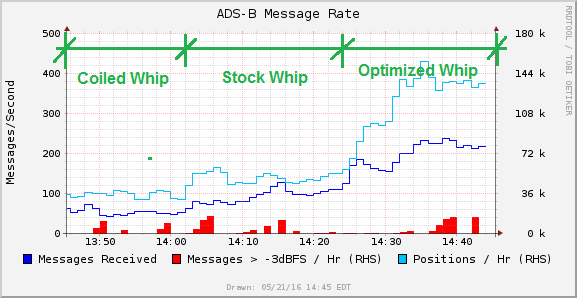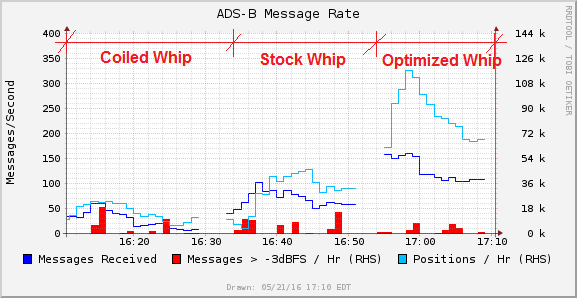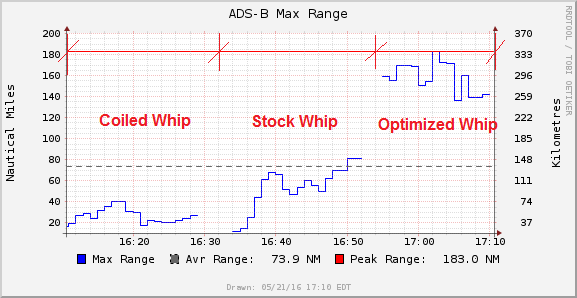Thank you for this great and easy to realize idea!
But before I cut my antenna allow one question:
If 1/2 wavelenght for 1090 MHz is 138 mm and I want my antenna to be 1/4 weavelenght (=69 mm) why should I make the cut at 67 mm (15 mm base + 52 mm whip)?
Announcement
Collapse
No announcement yet.
Trial Run Results for Three Types of Whip Antennas
Collapse
X
-
@Ben311
Hello Ben
There is another step to further improve: Enlarge the tiny ground plane provided by the 1 inch (25mm) dia mag mount base by placing it over a metallic surface like a metallic sheet, plate or a can.
Please see the following thread which demonstrates the boost when antanna was placed over a metallic surface (a food can), compared to when it was placed over a non metallic surface (inverted glass).
Trial Run Results for Four Sizes of Ground Planes
.
Leave a comment:
-
Hello all,
I just registered a new account to let everyone know, that this is a genius idea. As I already ordered a new antenna yesterday, I gave it a try and cut the old indoors-antenna. Now lots and lots of planes show up and my range increased by about 30-40 nm.
Thanks
Ben
Leave a comment:
-
So we may conclude; bigger is not always better. It's how you use your antenna.. :P XD haha
Leave a comment:
-
Yes, it is 1/2 wavelength.Originally posted by HNJAMeindersma View PostIs the stock whip exactly 1/2 wavelength?
The total length of whip is 115 mm removable part + 15 mm inside the base = 130 mm.
The 1/2 wavelength at 1090 MHz is 138 mm.
Therefore for all practical purposes, the stock whip is 1/2 wavelength.
However the impedance of 1/2 wavelength whip, even with ground-plane enlarged, is several hundred ohms. This gies a poor impedance match with 75 input impedance of the receiver (db-t usb dongle) and SWR is higher than 2.5
On the other hand, the impedance of 1/4 wavelength whip with ground-plane enlarged is between 50 and 75 ohms, and provides an almost perfect impedance match & SWR is 1.5 or less.
This is the reason the whip chopped to 1/4 wavelength performs better than full length whip.
Please note that 52 mm removable part + 15 mm inside base = 67 mm = 1/4 wavelength at 1090 MHz.
25164814131_839b1981bc_o.png. . . . 24872604509_2bc46a22db_o.pngLast edited by abcd567; 2016-05-29, 02:05.
Leave a comment:
-
very interesting, im going to try it
just to get a more info... why a trimmed antenna works better? did you start cutting little and test?
i found really interesting your tests and results. thanks for sharing with us!
If someone need space to upload a .iso .img or any kind of software i can help you, i have spare space in my servers.
Leave a comment:
-
So essentially, if you aren't using it for tv or any other frequency. Chop it!
Leave a comment:
-
Trial Run Results for Three Types of Whip Antennas
Please scroll down to see the test result graphs at the bottom.
(1) The three antennas under test were:- (a) Coiled Whip
(b) Stock Whip
(c) Optimized Whip
(2) In order to minimize number of variables, only the removable parts of Whips were interchanged. All other hardware, location, and software/gain settings were identical. Even the same mag mount base & RG174 coax cable was used for all the three whips.
(3) In order to be sure that results are not influenced due to fluctuation in traffic, test were conducted twice.- (a) First test between 2pm & 3 pm
(b) Repeat test between 4pm & 5pm
Photo 1 - Three Antennas

Photo 2 - Test Setup

Photos 3 & 4 - Results of First Test


Photos 5 & 6 - Results of Repeat Test

 Tags: None
Tags: None
- (a) Coiled Whip

Leave a comment: